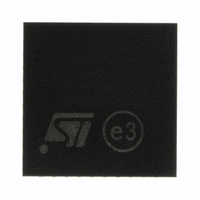SN260Q STMicroelectronics, SN260Q Datasheet - Page 13

SN260Q
Manufacturer Part Number
SN260Q
Description
IC ZIGBEE/802.15.4 PROC 40-QFN
Manufacturer
STMicroelectronics
Datasheet
1.SN260Q.pdf
(47 pages)
Specifications of SN260Q
Frequency
2.4GHz
Modulation Or Protocol
802.15.4
Applications
ZigBee™
Power - Output
-32dBm ~ 5dBm
Sensitivity
-97.5dBm
Voltage - Supply
2.1 V ~ 3.6 V
Current - Receiving
35.5mA
Current - Transmitting
35.5mA
Data Interface
PCB, Surface Mount
Antenna Connector
PCB, Surface Mount
Operating Temperature
-40°C ~ 85°C
Package / Case
40-QFN
For Use With
497-6404 - BOARD EVAL SPZB260 MOD FOR STR9497-5990 - KIT EVAL REVA FOR ZIGBEE497-5879 - NETWORK DEVELOPMENT FOR SN260497-5877 - KIT RADIO CARRIER FOR SN260
Lead Free Status / RoHS Status
Lead free / RoHS Compliant
Memory Size
-
Data Rate - Maximum
-
SN260
Top-level functional description
The SN260 integrates hardware support for a Packet Trace module, which allows robust
packet-based debug. This element is a critical component of InSight Desktop, the Ember
software IDE, providing advanced network debug capability when coupled with the InSight
Adapter.
The SN260 integrates a 16-bit XAP2b microprocessor developed by Cambridge
Consultants Ltd. This power-efficient, industry-proven core provides the appropriate level of
processing power to meet the needs of the Ember ZigBee-compliant stack, EmberZNet. In
addition, the SIF module provides a non-intrusive programming and debug interface
allowing for real-time application debugging.
The SN260 exposes the Ember Serial API over either a SPI or UART interface, which allows
application development to occur on a Host platform of choice. The SPI interface uses the
four standard SPI signals plus two additional signals, nHOST_INT and nWAKE, which
provide an easy-to-use handshake mechanism between the Host and the SN260. The
UART interface uses the two standard UART signals and also supports either standard
RTS/CTS or XON/XOFF flow control.
The integrated voltage regulator generates a regulated 1.8V reference voltage from an
unregulated supply voltage. This voltage is decoupled and routed externally to supply the
1.8V to the core logic. In addition, an integrated POR module allows for the proper cold start
of the SN260.
The SN260 contains one high-frequency (24 MHz) crystal oscillator and, for low-power
operation, a second low-frequency internal 10 kHz oscillator.
The SN260 contains two power domains. The always-powered High Voltage Supply is used
for powering the GPIO pads and critical chip functions. The rest of the chip is powered by a
regulated Low Voltage Supply which can be disabled during deep sleep to reduce the power
consumption.
13/47












